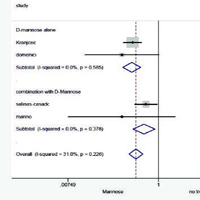Oral D mannose in the prevention and treatment of recurrent urinary tract infections: A review

All claims expressed in this article are solely those of the authors and do not necessarily represent those of their affiliated organizations, or those of the publisher, the editors and the reviewers. Any product that may be evaluated in this article or claim that may be made by its manufacturer is not guaranteed or endorsed by the publisher.
Accepted: 15 June 2021
Authors
The results of several studies reveal that antibiotics may promote treatment resistance by causing alterations in the intestinal flora. The development of a gut reservoir of resistant bacteria promotes the development of UTIs through autoinfection. This review aims to address clinical reliability, efficacy and safety of long-term treatment with oral D mannose for the prevention of Recurrent Urinary Tract Infections (RUTI) in females. A comprehensive MEDLINE, Embase, Scopus and Cochrane search was performed for English language reports published before December 2018 using the term “recurrent urinary tract infections and D mannose” was carried out. We searched Medline, Embase, Scopus and the Cochrane Register of Controlled Trials from January 2010 to December 2018. Eligible studies did not include non-oral therapy, local (vaginal) treatment in women with recurrent UTIs. We identified eligible original articles. A few limitations of the review are the heterogeneity of the available studies, their different rational and aim, the assumption of D mannose for prophylaxis or treatment of recurrent UTIs. Oral D mannose performs well in the prevention of UTIs recurrences, significant improvement of urinary symptoms was observed, the disease- free time was longer in the groups of patients under prophylaxis with D mannose in comparison with control groups (no treatment, antibiotic prophylaxis, prophylaxis with Proanthocyanidin (PAC) etc. The review has limitations, as the studies are heterogeneous, the meta-analysis requires classifications that can also be arbitrary. Furthermore, single-arm studies are not included. Some of the authors found this evidence inconclusive, which results as a limitation of the study. D mannose prolonged the recurrence-free interval of recurrent UTIs, thus reducing the prolonged or cyclical use of antibiotics, improving clinical symptoms, with a significant difference between treatment and control groups (no treatment, antibiotic prophylaxis, prophylaxis with Proanthocyanidin). However, most clinical trials used an association of different substances commingled with D mannose, dosages and regimens of D mannose were different. For this reason, the evidence of the efficacy of D mannose remains low.






